FOR a parent whose child is facing death, the future looks bleak. But at the world’s first children’s hospice, staff ensure that life is celebrated, as our writer reports.

At the end of the main corridor in Helen House, the world’s first children’s hospice, lies the Little Room. It’s smaller than the other eight bedrooms, simply furnished, and it’s the place parents dread.That’s because it’s where they come when their child has died: the room is kept cold to preserve the body and give the family time to say their goodbyes and give their last hugs. Of course, there are tears here but also laughter and smiles: the room has been decorated as a fairy castle and a spaceship over the years. One time, on a boiling hot day, a grieving family took a break for a water fight on the grass outside.

We can’t see the room today because it’s being used, but we visit the Starfish Room, the equivalent in Douglas House, the sister hospice for 16 to 35 year olds next door. The room is at the centre of the seven-bedroom building. There’s a discreet door at the back that leads directly outside via a long corridor.It was designed for coffins to enter and leave by – but no one can ever remember it being used. “The young people tell us they came in through the front door and they will go out of the front,” says Clare. This normalising of death as part of life is what makes hospices so special.On the bed in the Starfish Room is a lovingly hand-stitched quilt featuring a parable that explains the room’s name. A man spends his days rescuing beached starfishes by throwing them back into the sea. “What possible difference are you making?” someone asks. “There are so many stranded starfish.”“It makes a difference to this one,” the man replies, holding up a single starfish.“It’s a philosophy to live by,” says Clare. “You can’t change the world completely but you can make a difference to your bit. This is what we are trying to do here.”
Helen House was the world’s first children’s hospice when it opened in 1982. It was the result of a friendship between a nun, Sister Frances Dominica, and the parents of a terminally ill two year old, Helen Worswick, desperate for respite care. It was built in the grounds of the convent; Douglas House was added in 2004.

It should be a subdued place because what could be more upsetting than a child’s death? But there’s a bustling, playful atmosphere. “It’s full of laughter and smiles. Staff aren’t moping about, there’s none of that tilted head earnest sympathy,” laughs Clare, who took over six months ago but has worked at the hospice for 11 years having trained as a nurse.“Children need to play and have fun, no matter what is going on in their lives.”There’s a huge, airy playroom at the heart of the modern building. There’s a teacher on site, a games room, a hot-tub room (where parents can take a well-deserved break), music room, sensory room and two family flats. There are 250 children on the books at any one time: some come here for end-of-life care in the last few weeks, others with life-limiting conditions come for respite care a few times a year to give their parents a break.Staff go to incredible lengths to make children’s last days happy and memorable: one 21 year old with cystic fibrosis was desperate to see the new Paddington film before he died, but the DVD hadn’t yet been released.Someone managed to get hold of a copy, it was couriered up from the company in London and a red carpet duly hired for the full premiere experience. Just yesterday, a six-year-old girl got her dearest wish: a trip round Oxford in a horse and cart.
As well as what Clare calls the “sparkly” experiences, they organise ordinary trips to the pub or to Costa Coffee for very ill or disabled young adults who want a slice of normal life.

At the moment there are four children in Helen House, plus one in the Little Room, and another three children waiting for end-of-life care, being visited at home by outreach nurses.There are 160 staff, ranging from doctors to cleaners and fundraisers, a teacher, music therapist, aromatherapist, play specialists and an army of volunteers. It costs £5.1 million a year to run both houses; Government funding makes up 12 per cent, but the rest is fundraising: £1 million comes in from 37 charity shops.Fundraising was challenging last year, possibly due in part to the negative publicity surrounding their founder, Sister Frances Dominica, who faced historic sexual-abuse allegations. She was under investigation but the CPS dropped the case. She denies the allegations, but had to resign from her role as a trustee of the hospice last December.All 54 children’s hospices in the UK have a similar struggle for funding: on average they receive only 21 per cent of their costs from local Government and health commissioners; the rest comes from fundraising. Many hoped David Cameron would introduce more central Government support, as his late son Ivan was cared for at Helen House and he has spoken fondly of the care the family received there. But nothing has happened as yet.
Perhaps it’s because as a society we don’t like to talk about children dying – unlike in past generations where child mortality was common.
“My great grandmother had 16 pregnancies,” says Clare. “They were used to child mortality. But now it’s a subject we don’t like to discuss.”
We adults may have lost this matter-of-fact attitude to death, but young children haven’t. “We’ve heard siblings talking in the playroom. One will say, ‘My sister has died,’ and the other will say, ‘Oh, my brother died,’ and they will debate ‘which one is the deadest’ or who died first,” says Clare. Her own daughters, aged eight and 10, recently had a discussion about how you would find a coffin for a tall man. “You could fold him in half,” suggested one.
Staff find that children at the hospice often know they are going to die, even if adults have not told them. Outreach nurse Shirley Jones recalls a boy of five who was nearing the end of life, but his parents were convinced he didn’t know.
One day he said he wanted everyone to go up to his bedroom and give presents to his brother, whose birthday was in a couple of months. They were puzzled but did it. He died later that day. “Whether they have knowledge or whether they are picking up on cues from family – sensing anxiety, we don’t know,” says Shirley.
Children are often accepting of death (rarely do nurses hear gravely ill children ask, “Why me?”), but teens and young adults are often angry, perhaps because they have more comprehension of what they are going to miss.
When it comes to end-of-life, children often know what they want. One seven-year-old boy who knew he was going to die was determined only to allow staff to give him limited help when the time came. He even had his wishes laminated to the equipment next to his bed.
When the time came, they abided by his wishes, even though his parents must have wanted to try anything to prolong his life. “His mum was incredibly gracious. She was so terribly upset but she did not ask us to carry on. I had so much admiration for her,” recalls Clare.
When a child dies, the impact on parents is all-consuming; bereavement teams at the hospice are often in touch with them years afterwards. “When a child dies, parents have lost the future,” says Clare. “We help them find a new normal, because it’s never the same again.”
By rights, her work should be gruelling and sad, but she loves it. “I’ve only had three bad days in 11 years here – and only one of them was to do with a death. Working here makes me treasure time with my own children. It makes me listen to them, hug them and spend as much time as possible with them. We know more than anyone how your whole life can change in a split second.”
Complete Article HERE!




















